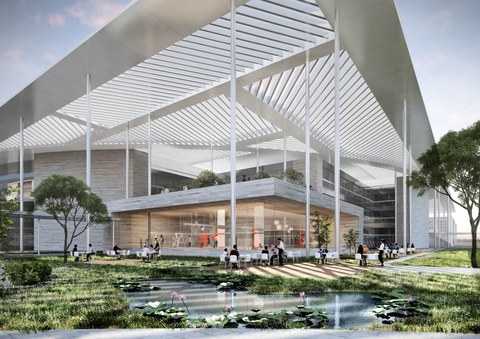May 10, 2021
Perspectives for Lusatia: From lignite to sustainable building
Consortium of TU Dresden researchers applying with an idea for a large-scale research center
Under the leadership of Prof. Manfred Curbach (TU Dresden), researchers have joined forces to advance the transformation of construction and bring about a change towards a world in balance. The idea of a building research center is supported by leading researchers from the University of Natural Resources and Life Sciences in Vienna, the Technical University of Munich, RWTH Aachen, ETH Zurich, Ruhr University Bochum, the UNU-FLORES Institute of the United Nations University, the German Academy of Engineering Sciences, as well as outstanding architects, such as the HENN architecture office, and civil engineers from the field. They have jointly submitted an application for a large-scale research center as part of the funding initiative "Knowledge creates prospects for the region" of the Free State of Saxony and the Federal Ministry of Education and Research. According to the proposal, the creation of two new large-scale research centers is intended to strengthen Germany's role as a hub of science and innovation while at the same time contributing to the transformation of the Saxon Lusatia and the central German mining region into attractive regions of the future.
The fossil-fuel phase-out in Lusatia is approaching fast. One of the consequences for the region will be the loss of jobs. Therefore, the population's worries in this regard are very legitimate. Europe's largest laboratory in the construction industry for research, development and transfer could offer a solution - for the location, but above all for the local people. A variety of companies would cluster in the vicinity of this major research center, ranging from start-ups to branches of Europe's largest building companies. "We are strongly convinced that this way, we can offer the people of Lusatia a realistic perspective for the future. The experience and the acquired know-how of this industrial culture could be an asset when working in a research laboratory of building", says Manfred Curbach, Director of the Institute of Concrete Structures at TU Dresden and spokesman for the research team. "The difference, however, is that the envisioned research and its transfer will trigger a building and material evolution that is climate and resource neutral, therefore noticeably reducing the burden on the environment."
The future of mankind will be decided in construction engineering. The built world affects everyone - regardless of activity, location, or stage of life. After all, one of the most basic human needs is a protective structural shell to provide warmth, protection from the elements and also safety. At the same time, however, the construction industry causes around 25% of CO2 emissions, consumes around 40% of the energy generated, and requires vast amounts of resources.
This allows for only one conclusion: In order to keep human life on earth livable, massive research efforts must be undertaken to end the construction-induced depletion of our planet and transform all building as well as the use of the built environment into a climate and resource neutral, long-lasting, variable, aesthetic and value-creating way of building.
Taking this aspect into account, all phases of construction and use need to be analyzed, adapted or innovated: from the idea to design, planning, calculation, construction, material extraction, manufacturing, transport, on-site construction, operation, maintenance, data management, upgrading and reuse, i.e. Evolutional Circular Economy at its best!
The areas of expertise required for this shift go far beyond the subjects traditionally found in building and construction. In addition to architects and construction engineers, experts from many disciplines will be required: Process engineering, materials science, biology, chemistry, computer science, mechanical engineering, electrical engineering, microelectronics, robotics, logistics, sustainability research, history, data analysis, sociology, law and political science.
The LAB - Lausitz Art of Building, as the proposed research center is called, aims to implement the most significant paradigm shift in the construction industry. This shift is to be achieved by using resource-efficient, climate-neutral high-performance materials and novel materials inspired by nature's models, by using the CO2 in the air as a raw material, and by utilizing high-performance materials such as carbon, basalt, and glass as components of multifunctional composite systems. The envisaged outcome is the creation of adaptive modular buildings with a high degree of flexibility that adapt to people and their requirements in terms of living and building. Innovative manufacturing processes, artificial intelligence and digitalization of the entire building industry are to enable sustainable homes with maximum comfort and the longest possible use.
A Living LAB would be launched in the center of Europe, between the urban metropolises of Berlin, Wrocław, Prague and Dresden. Researchers from all over the world will form its foundation. "With the LAB, we want to boost the region's economic performance. In the future, thanks to the close interaction between science and entrepreneurship as well as intense and interdisciplinary cooperation, Lusatia will stand for innovation with heart and mind," says Curbach.
Media enquiries:
Sandra Kranich
Tel.: 0351 484-56714

